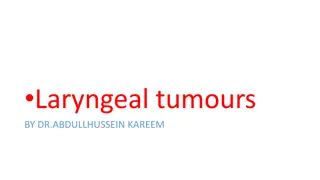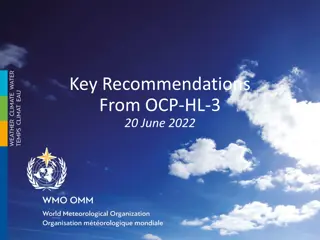
Diagnostic Algorithm for Cushing's Syndrome Evaluation and Treatment
Discover the diagnostic algorithm for patients suspected of having Cushing's syndrome, along with associated tumors and treatment options. Explore the impact of various hormones and conditions on the body, including SIADH, SCLC, and more. Learn about different imaging and treatment modalities used in managing these conditions.
Download Presentation

Please find below an Image/Link to download the presentation.
The content on the website is provided AS IS for your information and personal use only. It may not be sold, licensed, or shared on other websites without obtaining consent from the author. If you encounter any issues during the download, it is possible that the publisher has removed the file from their server.
You are allowed to download the files provided on this website for personal or commercial use, subject to the condition that they are used lawfully. All files are the property of their respective owners.
The content on the website is provided AS IS for your information and personal use only. It may not be sold, licensed, or shared on other websites without obtaining consent from the author.
E N D
Presentation Transcript
ACTH Cushing SCLC (3-7% SCLC) Ca : , , , , ,
Table 45-1: Tumors Associated with Ectopic Adrenocorticotropic Hormone Tumor Type Crapo4 Odellb Liddle, Island, Ney, et al.1 Howlett, Drury, Perry, et al.a Wajchenberg, Mendonca, Liberman, et al.2 Small cell lung carcinoma 50 49 19 8 50 Bronchial carcinoid 8 8 37 17 2 Thymic carcinomas 10 12 12 25 10 Pancreas 10 6 12 25 10 Pheochromocytoma 3 2 6 25 5 2 6 5 Medullary cancer of the thyroid Gastrointestinal carcinoid 6 Adenocarcinoma 7 2 Miscellaneous 10 10 12 18
Figure 45-1 Diagnostic algorithm for the evaluation of patients with suspected Cushing's syndrome.
(SIADH) vasopressin (ADH) atrial natriuretic peptide UNa> 40 mmol/L , , , , , SIADH SCLC (75%), NSCLC, Ca - Demeclocycline
Trousseau Trousseau A. Phlegmasia alba dolens. Clinique medicale de l'Hotel Dieu de Paris, London. N Sydenham Soc 1865;3:94 , , Ca : , , : .
(50% ) , , , : TNF-a, IL-6, interferon- , TGF- : 1-1.5 g kg 25-40% ( ) : (Megace), .
Table 45-3: Pigmented Lesions and Keratoses Disease Description Malignancy Cause Comments Unknown Acanthosis nigricansa Gray-brown symmetric velvety plaques on the neck, axilla, flexor areas, and anogenital region Adenocarcinomas; predominantly gastric Benign form present from birth and associated with various syndromes Tripe palmsa Gastric, lung Unknown Hyperpigmented velvety thickened palms with hyperkeratotic ridges Often associated with acanthosis nigricans May be seen in benign conditions Generalized melanosis Diffuse gray-brown skin pigmentation Melanoma, adrenocorticotrophic hormone producing tumors Melanin deposits in dermis Gastric, lymphoma, breast Unknown Leser-Tr lat signa Sudden appearance of seborrheic keratoses Differentiate from benign seborrheic keratoses Unknown Predominantly male disorder Acrokeratosis paraneoplastica or Bazex's diseasea Symmetric, psoriasiform acral hyperkeratosis Squamous cell carcinoma of the esophagus, head and neck, lung Paget's disease Erythematous keratotic patch over areola/nipple, urogenital, or perianal area Breast, uterine, ovarian, prostate, anal Paget cells are either cancerous or Langerhans' cells Occurs in fewer than 3% of breast cancers; extramammary Paget's overlies the area of cancer Unknown Sweet's syndromea Erythematous painful raised cutaneous plaques Hematologic malignancies, various carcinomas May respond to steroids; 10% to 15% associated with cancer Unknown Neutrophilic infiltrate Pyoderma gangrenosuma Painful papules, ulcers, violaceous borders and purulent exudates Basal, squamous skin cancers; cutaneous T-cell non-Hodgkin's lymphoma
Table 45-4: Erythemas Disease Description Malignancy Cause Comments Unknown Erythema gyratum repensa Advancing concentric rings of erythema with trailing scales Lung, breast, uterus, gastrointestinal cancers 80% Associated with malignancies Glucagonoma Somatostatin beneficial Necrolytic migratory erythemaa Macules and papules progressing to epidermal necrolysis Glucagon or metabolic product Flushinga Episodic reddening of face and neck Carcinoids, medullary thyroid carcinoma Serotonin or other vasoactive peptides Unknown Exfoliative dermatitis Progressive erythema followed by scaling Cutaneous T-cell and other lymphomas, Hodgkin's disease Accounts for 10 20% of all exfoliative dermatitis
Table 45-5: Miscellaneous Lesions Disease Description Malignancy Cause Comments Acquired ichthyosisa Unknown Generalized dry, crackling skin, hyperkeratosis, rhomboidal scales Hodgkin's disease, other lymphomas, multiple myeloma, Kaposi's sarcoma Should be differentiated from hereditary ichthyosis, which occurs before age 20 y Dermatomyositisa Miscellaneous Unknown Erythema or telangiectasias of the knuckles, chest, periorbital region Malignant disease reported in up to 50%, precedes carcinoma by days to years Pachydermoperiostosisa Lung Unknown Thickening of skin, lips, ears, lids; forehead, scalp; clubbing; excessive sweating May be seen in lung cancer, and lung abscess and benign tumors Unknown High association with cancer Hypertrichosis lanuginosa acquisita (malignant down)a Rapid development of fine, long, silky hair, especially on ears and forehead Lung, colon, bladder, uterus, gallbladder Amyloid Unknown Waxy yellow plaques and nodules Multiple myeloma, Waldenstr m's macroglobulinemia Also associated with primary systemic amyloidosis Muir-Torre syndromea Sebaceous gland neoplasm Colon cancer, lymphoma Unknown Pruritusa Unknown Lymphomas, leukemias, multiple myeloma, central nervous system tumors, abdominal tumors Failure to determine a cutaneous cause of generalized pruritus necessitates an evaluation for an underlying systemic disease
Table 45-6: Hereditary Disorders Disease Description Malignancy Heredity Comments Thyroid, breast carcinomas Cowden's disease (multiple hamartoma syndrome) Fibromas of oral mucosa with "cobblestoning" of the tongue, facial trichilemmomas Autosomal dominant Associated with multiple hamartomas, lipomas, neuromas, hemangiomas, thyroid adenomas Gardner's syndrome Bony exostoses, epidermal cysts, sebaceous cysts, dermoid tumors, lipomas, fibromas Adenocarcinoma of large or small bowel Autosomal dominant Hallmark is polyposis of the colon GI adenocarcinomas Peutz-Jeghers syndrome Hamartomatous polyps of the GI tract and mucocutaneous pigmentation of the lips, face, and oral mucosa Autosomal dominant Associated with benign or malignant neoplasm Esophageal carcinoma Keratosis palmaris et plantaris (tylosis) Hyperkeratosis of palms and soles after age 10 y Autosomal dominant 95% Incidence of carcinoma by age 65 y Pheochromocytoma Neurofibromatosis (von Recklinghausen) Neurofibromas, caf au lait spots Autosomal dominant Malignancies develop in a minority of patients Nevoid basal cell carcinoma syndrome Multiple basal cell carcinomas, pits on soles and palms, jaw cysts, skeletal abnormalities Medulloblastoma, fibrosarcoma (jaw) Autosomal dominant Infrequent association with internal malignancy Neurologic malignancies Tuberous sclerosis (Bourneville) Pigmented macules, adenomas, fibromas Autosomal dominant Malignancies develop in a minority of patients Neurologic malignancies Cerebelloretinal hemangioblastoma (von Hippel-Lindau) Retinal malformation, papilledema Autosomal dominant Malignancies develop in a minority of patients
Table 45-6: Hereditary Disorders (contd) Neurologic malignancies Encephalotrigeminal syndrome (Sturge- Weber) Capillary or cavernous hemangiomas within the cutaneous distribution of the trigeminal nerve Autosomal dominant Malignancies develop in a minority of patients Ataxia-telangiectasia Telangiectasias Lymphomas, leukemias Autosomal recessive IgA IgE deficiency; sinopulmonary infections, tumors in <10% Bloom's syndrome Leukemias Photosensitivity, telangiectasias, erythema of face Autosomal recessive Stunted growth, high incidence Fanconi's anemia Patchy hyperpigmentation Leukemias High incidence Autosomal recessive Lymphomas High incidence Ch diak-Higashi syndrome Recurrent pyoderma, giant melanosomes, dilution of skin and hair color Autosomal recessive Werner's syndrome (adult progeria) Scleroderma-like changes, premature aging, leg ulcers, short stature Sarcomas, meningiomas, others Autosomal recessive Cancers in approximately 10% Lymphomas Sex linked (male) >10% Incidence Wiskott-Aldrich syndrome Eczematous dermatitis, pyoderma Recurrent infections Lymphomas, leukemias Sex linked >5% Incidence Bruton's sex-linked agammaglobulinemia
Table 45-7: Estimated Incidence of Neurologic Disorders That Are Paraneoplastic Syndromes Syndrome % Paraneoplastic Lambert-Eaton myasthenic syndrome 60 Subacute cerebellar degeneration 50 Subacute sensory neuronopathy 20 Opsoclonus-myoclonus (children) 50 Opsoclonus-myoclonus (adults) 20 Sensory motor peripheral neuropathy 10 Encephalomyelitis 10 Dermatomyositis 10 (From Posner JB. Paraneoplastic syndromes. Neurol Clin 1991;9:919, with permission.)
Limbic Encephalitis , , , SCLC anti-Hu Ca (5%) anti-Ri : 40%
nti-CAR (carcinoma-associated retinal antigen) (SCLC) Opsoclonus-Myoclonus Anti-Ri Ca
Table 45-8: Antineuronal Antibodies and Associated Paraneoplastic Syndromes and Cancers Antibody Site of Activity Genes Clinical Syndrome Cancers Cellular Function Anti-Hu (ANNA-1) Panneuronal RNA binding HuD, HuC, Hel- N1/N2 Paraneoplastic encephalomyelitis, paraneoplastic sensory neuronopathy, PCD, autonomic dysfunction SCLC, sarcoma, neuroblastoma Anti-Ri (ANNA-2) Nova-1 RNA binding Paraneoplastic opsoclonus-myoclonus, PCD Central nervous system neurons Breast, gynecologic, SCLC, bladder Anti-Yo (APCA) Purkinje cell PCD CDR34/62/3, PCD-17 Leucine zipper Ovary, uterus, breast, SCLC Anti-Tr Purkinje cell MAZ PCD Leucine zipper Hodgkin's, non- Hodgkin's lymphoma Interacts with DCC gene product Anti-VGCC Ach release Lambert-Eaton myasthenic syndrome Presynaptic neuromuscular junction MysB, Synaptotagmin SCLC, Hodgkin's disease Anti-CAR Photoreceptors Recoverin Cancer-associated retinopathy SCLC, melanoma Calcium binding Antiamphiphysin Amphiphysin Stiff-person syndrome, encephalitis Breast, SCLC Synapse, central nervous system neurons Synaptic vesicle protein Anti-AchR ?MHC Ach receptor Myasthenia Thymoma Postsynaptic neuromuscular junction Oligodendrocyte CRMP-5 Neuropathy, uveitis, chorea, ataxia Anti-CV2, anti CRMP-5 Axonal growth factor SCLC, renal cell, breast, lymphoma Nicotinic AchR Dysautonomia SCLC, thymoma Anti-AchR (nicotinic) Postsynaptic, ganglionic AchR, nicotinic Anti-Ta Nucleus Ma1, Ma2 ? Limbic encephalitis Testis Ach, acetylcholine; AchR, acetylcholine receptor; ANNA, antineuronal nuclear antibody; APCA, antiparietal cell antibody; CAR, carcinoma- associated retinal; CRMP, collapsin response mediator protein-2; MHC, major histocompatibility complex; PCD, paraneoplastic cerebellar degeneration; SCLC, small cell carcinoma of the lung; VGCC, voltage-gated calcium channel.






















